maintenance AUDI Q5 2015 Owners Manual
[x] Cancel search | Manufacturer: AUDI, Model Year: 2015, Model line: Q5, Model: AUDI Q5 2015Pages: 302, PDF Size: 75.01 MB
Page 6 of 302
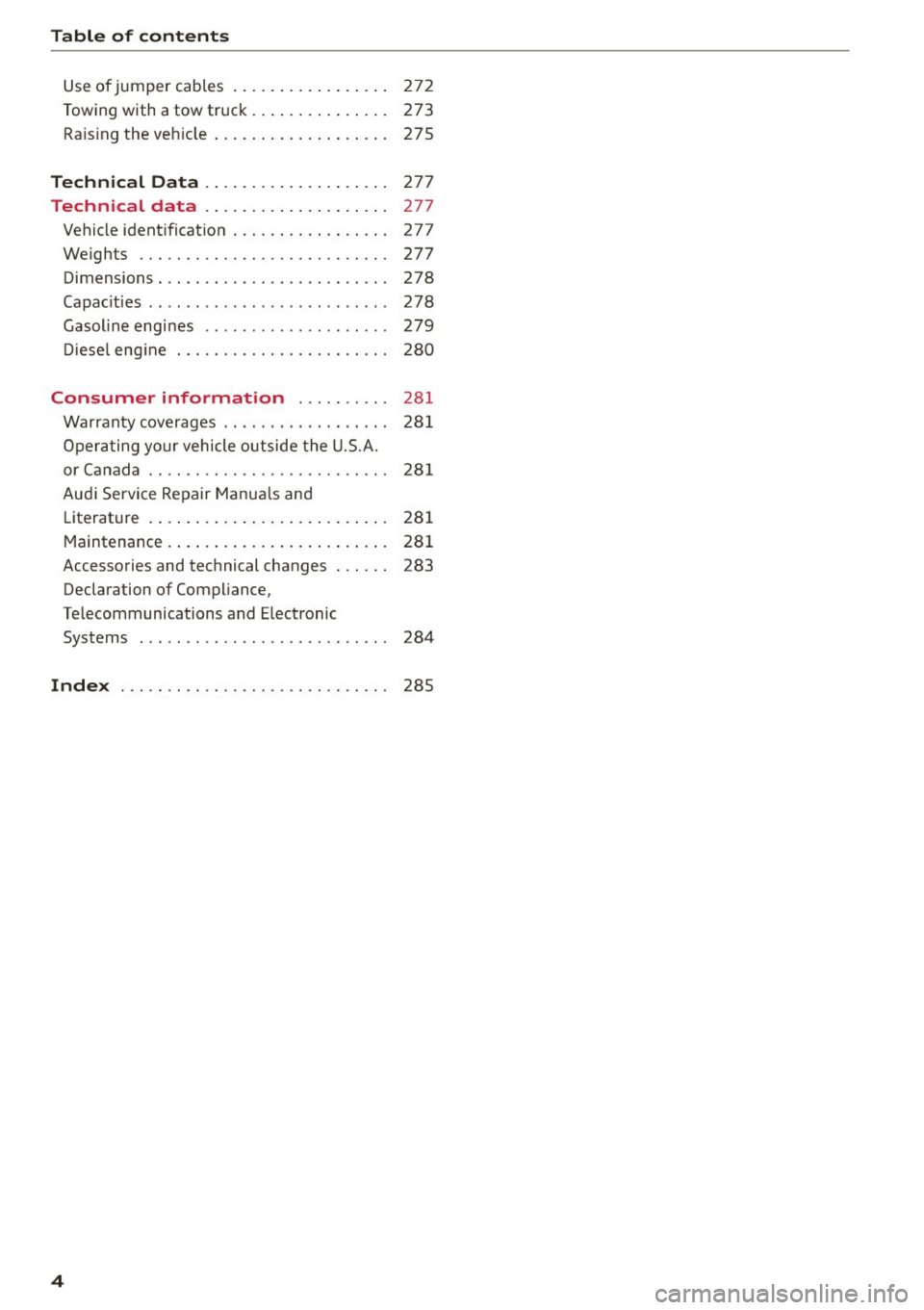
Table of contents
Use of jumper cables . . . . . . . . . . . . . . . . . 272
Towing with a tow truck. . . . . . . . . . . . . . . 273
Raising the vehicle . . . . . . . . . . . . . . . . . . . 275
Technical Data . . . . . . . . . . . . . . . . . . . . 277
Technical data . . . . . . . . . . . . . . . . . . . . 277
Vehicle identificat ion . . . . . . . . . . . . . . . . . 277
Weights . . . . . . . . . . . . . . . . . . . . . . . . . . . 277
Dimensions. . . . . . . . . . . . . . . . . . . . . . . . . 278
Capac ities . . . . . . . . . . . . . . . . . . . . . . . . . . 278
Gasoline engines . . . . . . . . . . . . . . . . . . . . 279
D iese l eng ine . . . . . . . . . . . . . . . . . . . . . . . 280
Consumer information . . . . . . . . . . 281
Warranty coverages . . . . . . . . . . . . . . . . . . 281
Operating your vehicle outside the U.S.A.
or Canada . . . . . . . . . . . . . . . . . . . . . . . . . . 281
Audi Service Repair Manuals and Literature . . . . . . . . . . . . . . . . . . . . . . . . . . 281
Maintenance. . . . . . . . . . . . . . . . . . . . . . . . 281
Accessories and technical changes . . . . . . 283
Declaration of Compliance,
Te lecommunications and E lectronic
Systems . . . . . . . . . . . . . . . . . . . . . . . . . . . 284
Index ..... ...... ........... .. .. ... 285
4
Page 7 of 302

M N
co
a:
co
,...., \!) 1.1'1
N 1.1'1 ,....,
In addition to this Owner's Manual , your Audi
comes with a Warranty
& Maintenance booklet.
Mor eover , depending on the model and the
eq uip ment, there may be add itiona l instruction
booklets delivered with your vehicle (for exam
ple, Operating Instructions for your Sound Sys
tem, Navigation System etc.).
If yo u are miss ing one of these publications, or if
you believe that the information is not complete,
contact your authorized A udi dealer for assis
tance.
The Warranty & Maintenance booklet
explains how you can keep your A udi in top driv
ing condition by having it serviced regu larly and
contains detailed information about the warran
ties covering your Audi. Always have the booklet
with you when you take your vehicle to an author ized Audi dealer for service. Your Audi Serv ice Ad
visor will record each scheduled serv ice and can
answer any questions you may have regarding
ho w to maintain your vehicle .
In Canada,
the vehicle literature is also avai lab le in French.
To obtain a copy, contact your dealer or write to:
Au Canada, on peut se procure r un exemplaire en
fran(ais de ce doc ument aupres du concession
naire ou de:
Aud i Canada
Client Assistance
Assistance a la Clientele
777 Bayly Street, West,
Ajax, Ontario LlS 7G7
If you sell your Audi
all literature should be left in the vehicle to make
the Warranty terms as well as a ll operating, safe
ty and maintenance information availab le to the
next owner.
If you change your address or if you bought
this Audi used
be sure to send in a "Notice of Address Change"/
"Notice of Used Car Purchase" post card. This
card can be found in the Warranty
& Maintenance
Owner 's Literature
booklet or obtained from your authorized Aud i
dealer.
It is in your own interest that we are able to
contact you should the need arise.
5
Page 82 of 302
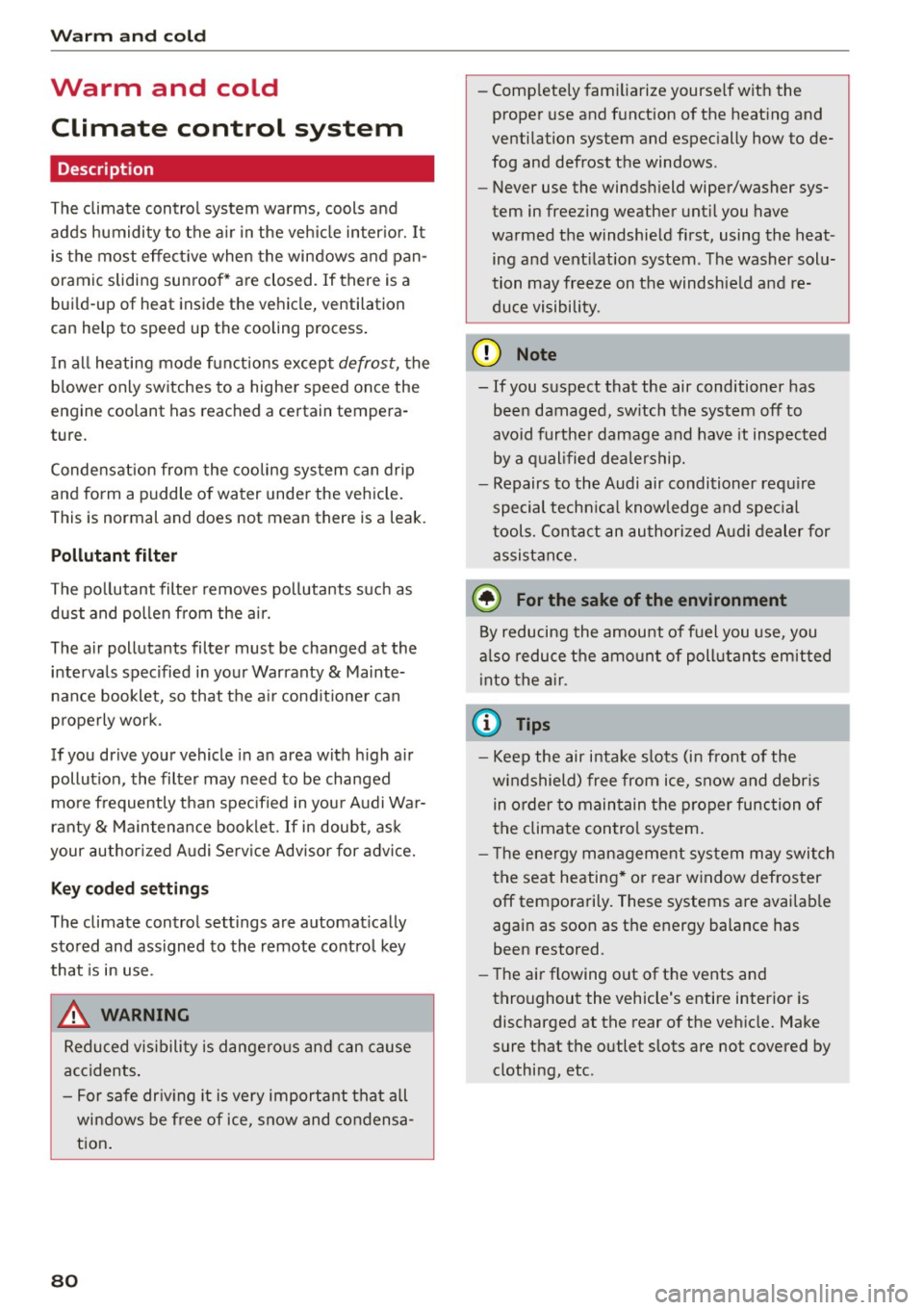
Warm and cold
Warm and cold Climate control system
Description
The climate control system warms, cools and
adds humidity to the air in the vehicle interior. It
is the most effective when the windows and pan
oramic sliding sunroof* are closed . If there is a
build-up of heat inside the vehicle, ventilation
can help to speed up the cooling proc ess.
In all heating mode functions except
defrost, the
blower only switches to a higher speed once the
engine coolant has reached a certain tempera
ture.
Condensation from the cooling system can drip
and form a puddle of water under the vehicle.
This is normal and does not mean there is a leak.
Pollutant filter
The pollutant filter removes pollutants such as
dust and pollen from the air.
The air pollutants filter must be changed at the
intervals specified in your Warranty & Mainte
nance booklet, so that the air conditioner can
properly work.
If you drive your vehicle in an area with high air pollution , the filter may need to be changed
more frequently than specified in your Audi War
ranty
& Maintenance booklet. If in doubt, ask
your authorized Audi Service Advisor for advice.
Key coded settings
The climate control settings are automatically
stored and assigned to the remote control key
that is in use .
.8, WARNING
Reduced visibility is dangerous and can cause
accidents.
- For safe driving it is very important that all
windows be free of ice, snow and condensa
tion.
80
- Completely familiarize yourself with the
proper use and function of the heating and
ventilation system and especially how to de
fog and defrost the windows .
- Never use the windshield wiper/washer sys
tem in freezing weather until you have
warmed the windshield first, using the heat
ing and ventilation system . The washer solu
tion may freeze on the windshield and re
duce visibility .
(D Note
-If you suspect that the air conditioner has
been damaged, switch the system off to
avoid further damage and have it inspected
by a qualified dealership.
- Repairs to the Audi air conditioner require
special technical knowledge and special
tools. Contact an authorized Audi dealer for
assistance.
@ For the sake of the environment
By reducing the amount of fuel you use, you
also reduce the amount of pollutants emitted
into the air.
(D Tips
-Keep the air intake slots (in front of the
windshield) free from ice, snow and debris
in order to maintain the proper function of
the climate control system.
- The energy management system may switch
the seat heating* or rear window defroster
off temporarily. These systems are available
again as soon as the energy balance has
been restored.
- The air flowing out of the vents and
throughout the vehicle's entire interior is
discharged at the rear of the vehicle. Make
sure that the outlet slots are not covered by clothing, etc.
Page 100 of 302
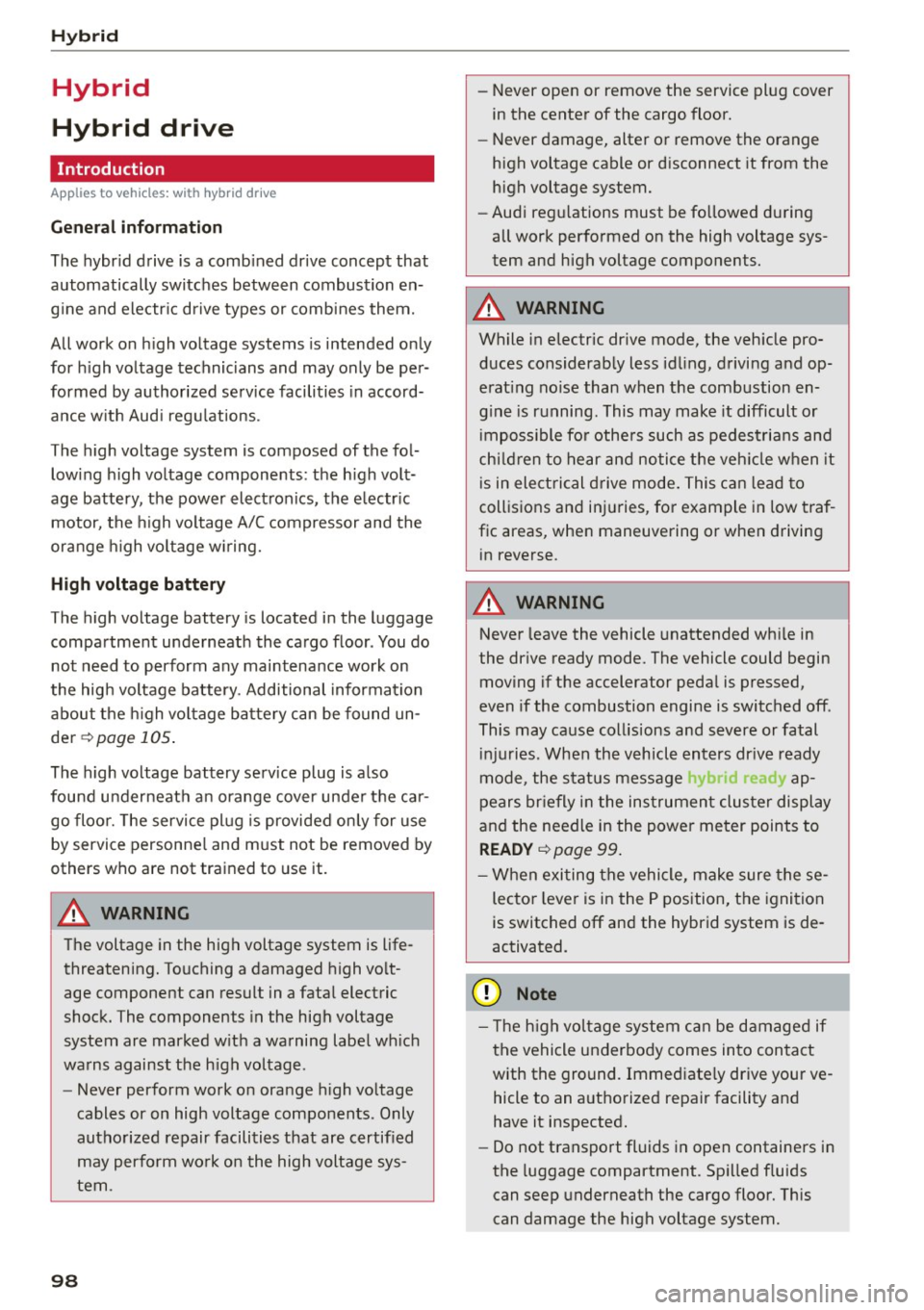
Hybrid
Hybrid
Hybrid drive
Introduction
App lies to veh icles: w ith hybr id drive
Gener al inf orm ation
The hybr id drive is a combined drive concept that
automatically switches between combustion en
g ine and electr ic drive types or combines them.
All work on h igh voltage systems is intended only
for h igh voltage technicians and may only be per
formed by authorized service facilities in accord
ance w ith Aud i regulations.
The high voltage system is composed of the fol lowing h igh voltage components: the h igh volt
age battery, the power electronics, the e lectr ic
motor, the h igh voltage A/C compressor and the
orange h igh vo ltage w iring.
High volta ge battery
The high voltage battery is located in the luggage
compartment underneath the cargo floor . You do
not need to perform any maintenance work on
the high voltage battery. Additional information
about the h igh vo ltage battery can be found un
der
r::!v page 105 .
The high voltage battery service plug is a lso
found underneath an orange cover under the ca r
go floo r. T he service plug is provided on ly for use
by service personne l and must not be removed by
others who are not trained to use it .
A WARNING
The voltage in the high voltage system is life
threatening. Touching a damaged high vo lt
age component can result in a fatal electric
shock. The components in the high voltage
system are marked w ith a warning label wh ich
warns against the h igh voltage.
- Never perform work on orange h igh voltage
cables or on high voltage components. Only
authorized repair facilities that are certified
may perform wo rk on the high voltage sys
tem.
98
- Never open or remove the service plug cover
in the center of the cargo floor.
- Never damage, alter o r remove the orange
high voltage cable or disconnect it from the
high voltage system.
- Aud i regu lations must be followed during
all work performed on the high voltage sys
tem and high voltage components.
A WARNING
While in electric dr ive mode, the veh icle pro
duces considerab ly less id ling, driving and op
erat ing no ise than when the combustion en
g ine is running. This may make it difficult or
impossible fo r othe rs such as pedes trians and
chi ld ren to hear and notice the veh icle when it
is in electrical drive mode . This can lead to
collisions and inj uries, for example in low traf
fic areas, when maneuvering or when driving
in reverse.
A WARNING
Never leave the vehicle unattended whi le in
the drive ready mode. The vehicle could begin moving if the accelerator peda l is pressed,
even if the combustion engine is switched off .
This may cause collisions and severe or fatal injuries. When the vehicle enters dr ive ready
mode, the status message
h• .,rid ii J ap
pears br iefly in the instrumen t cluster display
and the needle in the powe r meter points to
READ Y ¢ page 99.
-When exi ting the vehicle, make sure these
lecto r lever is i n the P position, the ignition
is switched off and the hybrid system is de
activated.
(D Note
- T he h igh voltage system can be damaged if
the vehicle underbody comes into contact
with the ground. Immediate ly drive your ve
hicle to an authorized repair facility and
have it inspected.
- Do not transport fluids in open containers in
the luggage compartment. Spill ed fluids
can seep underneath the cargo floor. This
can damage the high voltage system.
-
Page 167 of 302
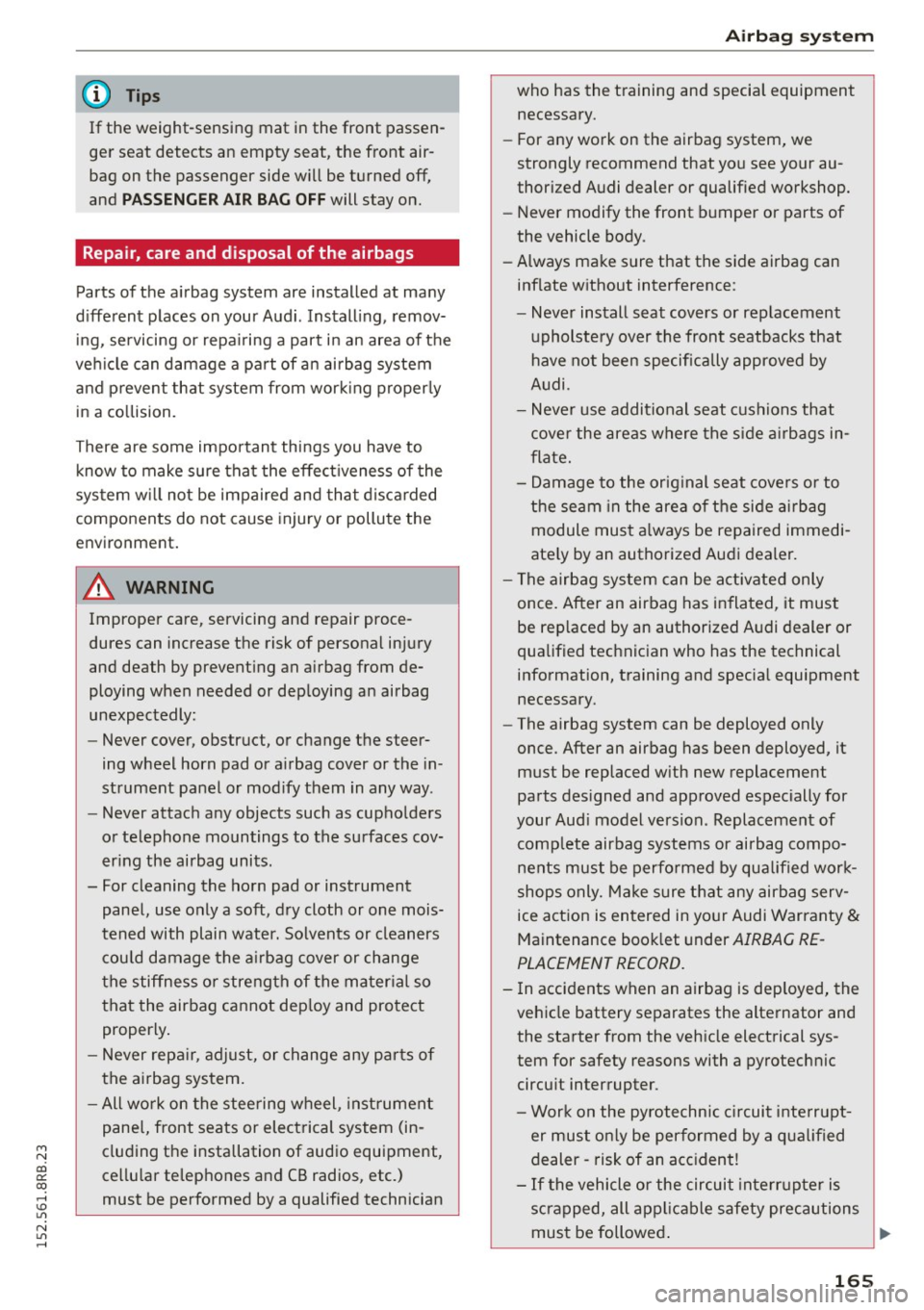
M N
co
a:
co
,...., \!) 1.1"1
N 1.1"1 ,....,
@ Tips
If the weight-sensing mat in the front passen
ger seat detects an empty seat, the front air
bag on the passenger side will be turned off,
and
PASSENGER AIR BAG OFF will stay on.
Repair, care and disposal of the airbags
Parts of the airbag system are installed at many
different places on your Audi. Installing, remov ing , servicing or repairing a part in an area of the
vehicle can damage a part of an airbag system and prevent that system from working properly in a collision.
There are some important things you have to know to make sure that the effectiveness of the
system will not be impaired and that discarded
components do not cause injury or pollute the
environment.
A WARNING
-
Improper care, servicing and repair proce
dures can increase the risk of personal injury
and death by preventing an airbag from de
ploying when needed or deploying an airbag
unexpectedly:
- Never cover, obstruct, or change the steer
ing wheel horn pad or airbag cover or the in
strument panel or modify them in any way .
- Never attach any objects such as cup holders
or telephone mountings to the surfaces cov
ering the airbag units .
- For cleaning the horn pad or instrument panel, use only a soft, dry cloth or one mois
tened with plain water. Solvents or cleaners could damage the airbag cover or change
the stiffness or strength of the material so
that the airbag cannot deploy and protect
properly.
- Never repair, adjust, or change any parts of
the airbag system.
- All work on the steering wheel, instrument
panel, front seats or electrical system (in
cluding the installation of audio equipment,
cellular telephones and CB radios, etc.)
must be performed by a qualified technician
Airbag system
who has the training and special equipment
necessary.
- For any work on the airbag system, we
strongly recommend that you see your au
thorized Audi dealer or qualified workshop.
- Never modify the front bumper or parts of
the vehicle body.
- Always make sure that the side airbag can
inflate without interference:
- Never install seat covers or replacement
upholstery over the front seatbacks that
have not been specifically approved by
Audi .
- Never use additional seat cushions that
cover the areas where the side airbags in
flate.
- Damage to the original seat covers or to
the seam in the area of the side airbag
module must always be repaired immedi
ately by an authorized Audi dealer.
- The airbag system can be activated only
once. After an airbag has inflated, it must
be replaced by an authorized Audi dealer or
qualified technician who has the technical
information, training and special equipment
necessary.
- The airbag system can be deployed only
once . After an airbag has been deployed, it
must be replaced with new replacement
parts designed and approved especially for
your Audi model version. Replacement of complete airbag systems or airbag components must be performed by qualified work
shops only. Make sure that any airbag serv
ice action is entered in your Audi Warranty
&
Maintenance booklet under AIRBAG RE
PLACEMENT RECORD.
- In accidents when an airbag is deployed, the
vehicle battery separates the alternator and
the starter from the vehicle electrical sys tem for safety reasons with a pyrotechnic
circuit interrupter .
- Work on the pyrotechnic circuit interrupt
er must only be performed by a qualified
dealer -risk of an accident!
- If the vehicle or the circuit interrupter is
scrapped, all applicable safety precautions
must be followed.
165
Page 201 of 302
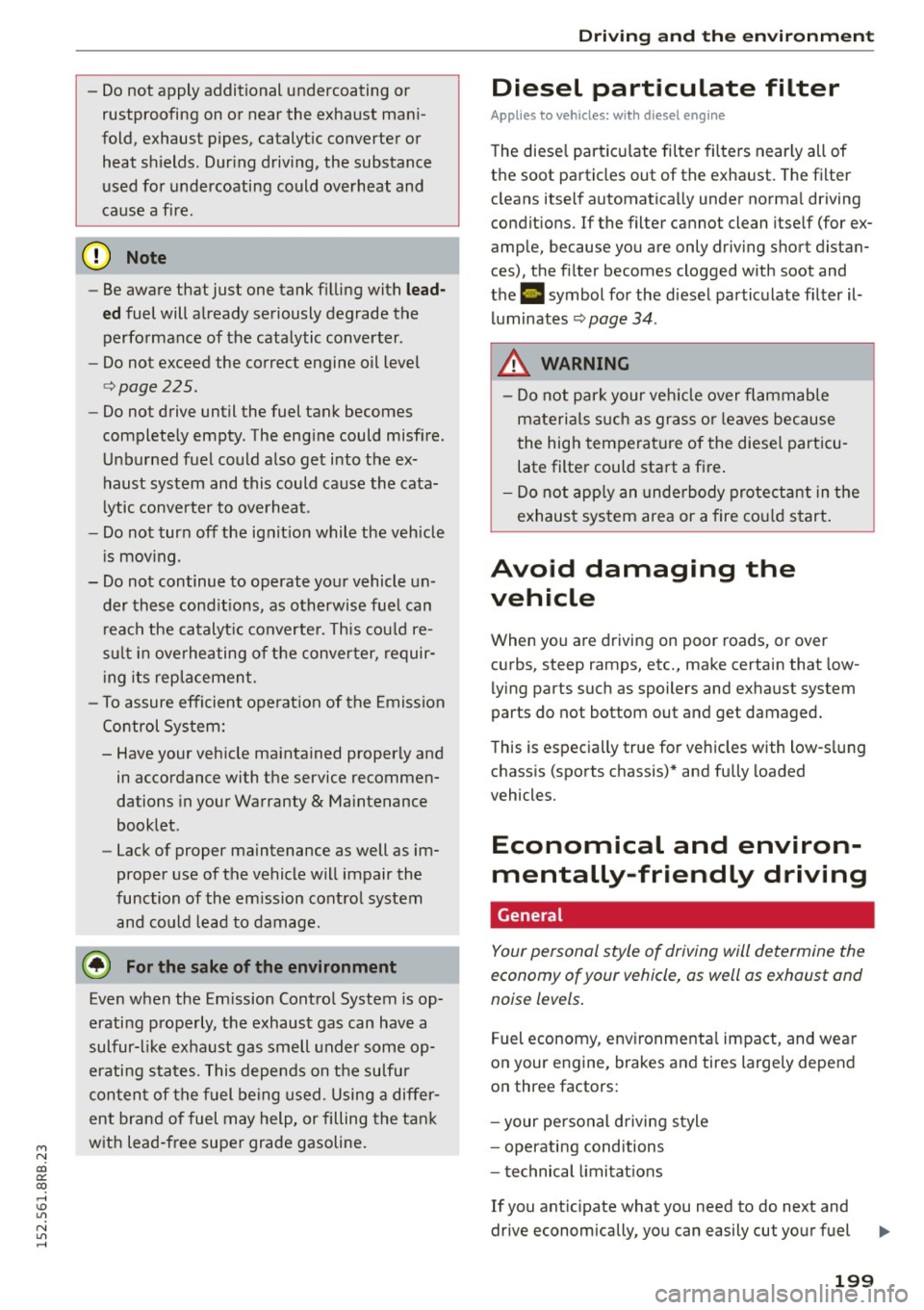
M N
co
a:
co
,...., \!) 1.1'1
N 1.1'1 ,....,
-Do not apply additional undercoating or
rustproofing on or near the exhaust man i
fold, exhaust pipes, catalytic converter or heat shields. During driving, the substance
used for undercoating could overheat and
cause a fire.
Q) Note
- Be aware that just one tank filling with lead
ed
fuel will already seriously degrade the
performance of the catalytic converter .
- Do not exceed the correct engine oil level
¢page 225.
-Do not drive until the fuel tank becomes
completely empty . The engine could misfire.
Unburned fuel could also get into the ex
haust system and this could cause the cata
l ytic converter to overheat.
- Do not turn off the ignit ion while the veh icle
i s mov ing .
- Do not continue to operate your vehicle un
der these cond it ions, as otherwise fuel can
reach the catalyt ic converte r. This cou ld re
su lt in overheating of the converter, requir
i ng its replacement.
- To assure efficient operat ion of the Emission
Control System:
- Have your veh icle maintained properly and
in accordance with the service recommen
dations in your Warranty
& Maintenance
booklet.
- Lack of proper maintenance as well as im
proper use of the vehicle will impair the
function of the em ission control system
and could lead to damage.
@) For the sake of the environment
Even when the Em ission Control System is op
erating properly, the exhaust gas can have a
sulfur-like exhaust gas smell under some op
erating states. This depends on the sulfu r
content of the fuel being used. Using a differ
ent brand of fuel may help, or filling the tank
wit h lead-free super grade gasoline.
Dri ving and th e en vir onm ent
Diesel particulate filter
Applies to veh icles: w ith diesel en gine
The diese l particu late filter filters nearly all of
the soot particles out of the exhaust. The filter
cleans itself automatica lly under norma l driving
conditions. If the filter cannot clean itself (for ex
ample, because you are only driving short distan
ces), the filter becomes clogged with soot and
the
II symbol for the diese l particulate filter il
luminates
¢ page 34 .
_&. WARNING
-Do not park your veh icle over flammab le
materia ls such as grass or leaves because
the high temperature of the diesel particu
late filter could start a fire .
-
-Do not app ly an underbody protectant in the
exhaust system area or a fire cou ld start.
Avoid damaging the
vehicle
When you are driving on poor roads, or over
curbs, steep ramps, etc., make certain that low
lying parts such as spoilers and exhaust system
parts do not bottom out and get damaged.
This is especially true for vehicles with low-slung
chassis (sports chassis)* and fully loaded
vehicles.
Economical and environ
mentally-friendly driving
General
Your personal style of driving will determine the
economy of your vehicle, as well as exhaust and
noise levels.
Fuel economy, environmenta l impact, and wear
on your engine, brakes and tires largely depend
on three factors:
- your pe rsonal d riving style
- operating conditions
- technical limitat ions
If you ant icipate what you need to do next and
drive economically, you can easily cut your fuel
199
Page 202 of 302
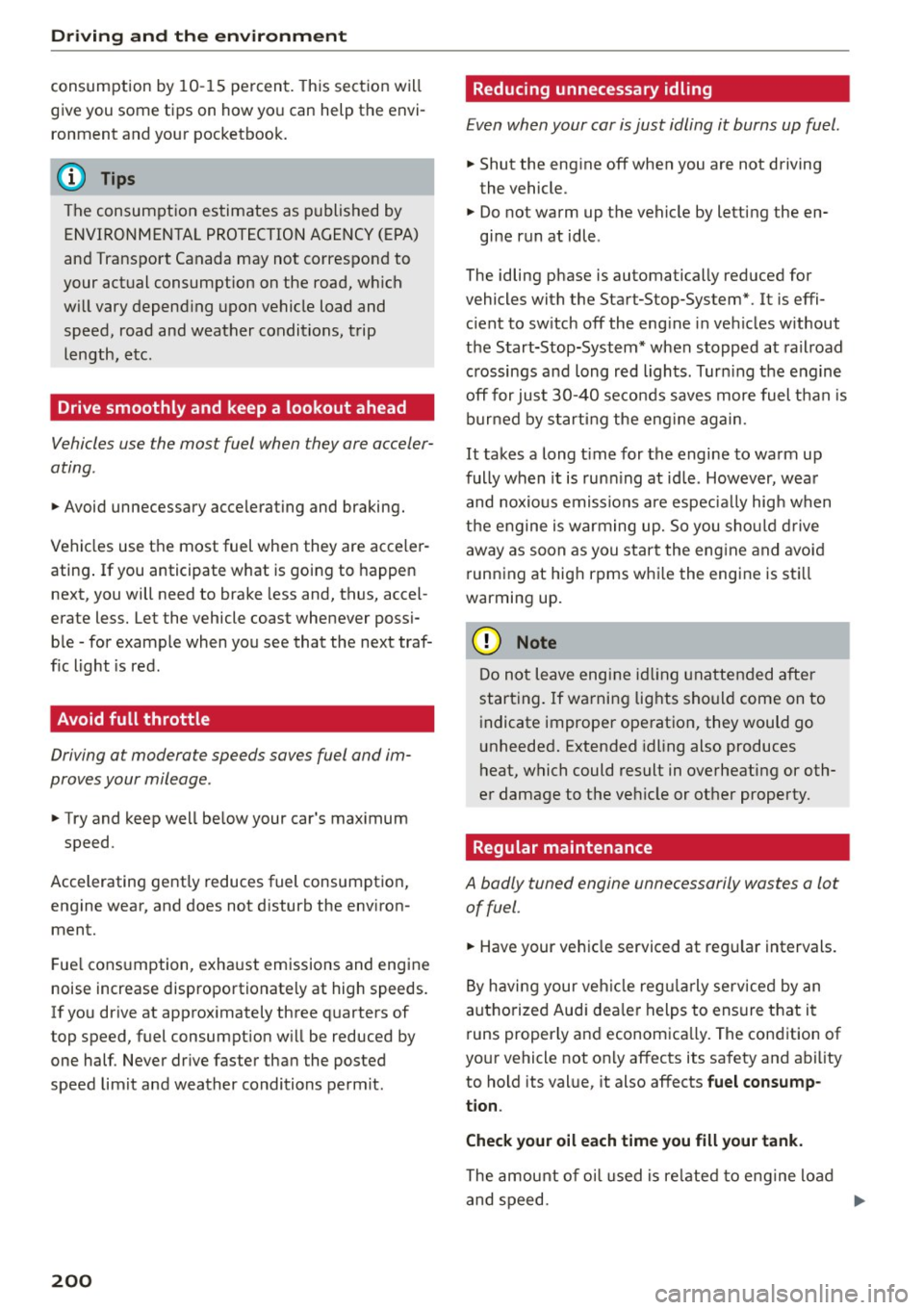
Driving and th e environment
consumption by 10-15 percent. This section will
give you some tips on how you can help the envi ronment and your pocketbook.
(D Tips
The consumption estimates as published by ENVIRONMENTAL PROTECTION AGENCY (EPA)
and Transport Canada may not correspond to
your actual consumption on the road, wh ich
w ill vary depend ing upon vehicle load and
speed, road and weather conditions, trip
length, etc .
Drive smoothly and keep a lookout ahead
Vehicles use the most fuel when they are acceler
ating .
"'Avoid unnecessary accelerating and braking.
Vehicles use the most fuel when they are acceler
ating . If you anticipate what is going to happen
next, you will need to brake less and, thus, accel
erate less. Let the vehicle coast whenever possi
ble -for example when you see that the next traf
fic light is red .
Avoid full throttle
Driving at moderate speeds saves fuel and im
proves your mileage.
"' Try and keep well be low your car's max imum
speed.
Accelerating gently reduces fuel consumption,
engine wear, and does not disturb the environ
ment.
Fue l consumption, exhaust emissions and engine
noise increase disproportionately at high speeds.
If you drive at approximately three quarters of
top speed, fuel consumpt ion w ill be reduced by
one half. Never dr ive faster than the posted
speed lim it and weather conditions permit .
200
· Reducing unnecessary idling
Even when your car is just idling it burns up fuel .
"'Shut the engine off when you are not driving
the vehicle.
"' Do not warm up the vehicle by letting the en-
gine run at idle .
The idling phase is automatically reduced for
vehicles with the Start-Stop-System*. It is effi c ient to sw itch off the eng ine in vehicles w ithout
the Start-Stop-System* when stopped at railroad
crossings and long red lights. Turn ing the engine
off for just 30-40 seconds saves more fuel than is
burned by start ing the eng ine again.
It takes a long t ime for the engine to warm up
fully when it is runn ing at id le . However, wear
and noxious emissions are especia lly high when
the engine is warming up. So you sho uld drive
away as soon as you start the eng ine and avoid
running at high rpms whi le the engine is s till
warming up.
Q) Note
Do not leave engine id ling unattended after
starting. If warning lights should come on to
indicate improper operation, they would go
unheeded. Extended idling also produces
heat, which could result in overheating or oth
er damage to the veh icle or other property.
· Regular maintenance
A badly tuned engine unnecessarily wastes a lot
of fuel.
"' Have your vehicle serviced at regu lar intervals.
By having your veh icle reg ularly serv iced by an
authorized Aud i dea le r helps to ensure that i t
runs proper ly and economica lly. The condition of
your vehicle not on ly affects its safety and ability
to hold its value, it also affects
fuel consump
t ion .
Chec k your oil ea ch t ime y ou fill your tank.
The amount of o il used is re lated to engine load
and speed. .,.
Page 203 of 302
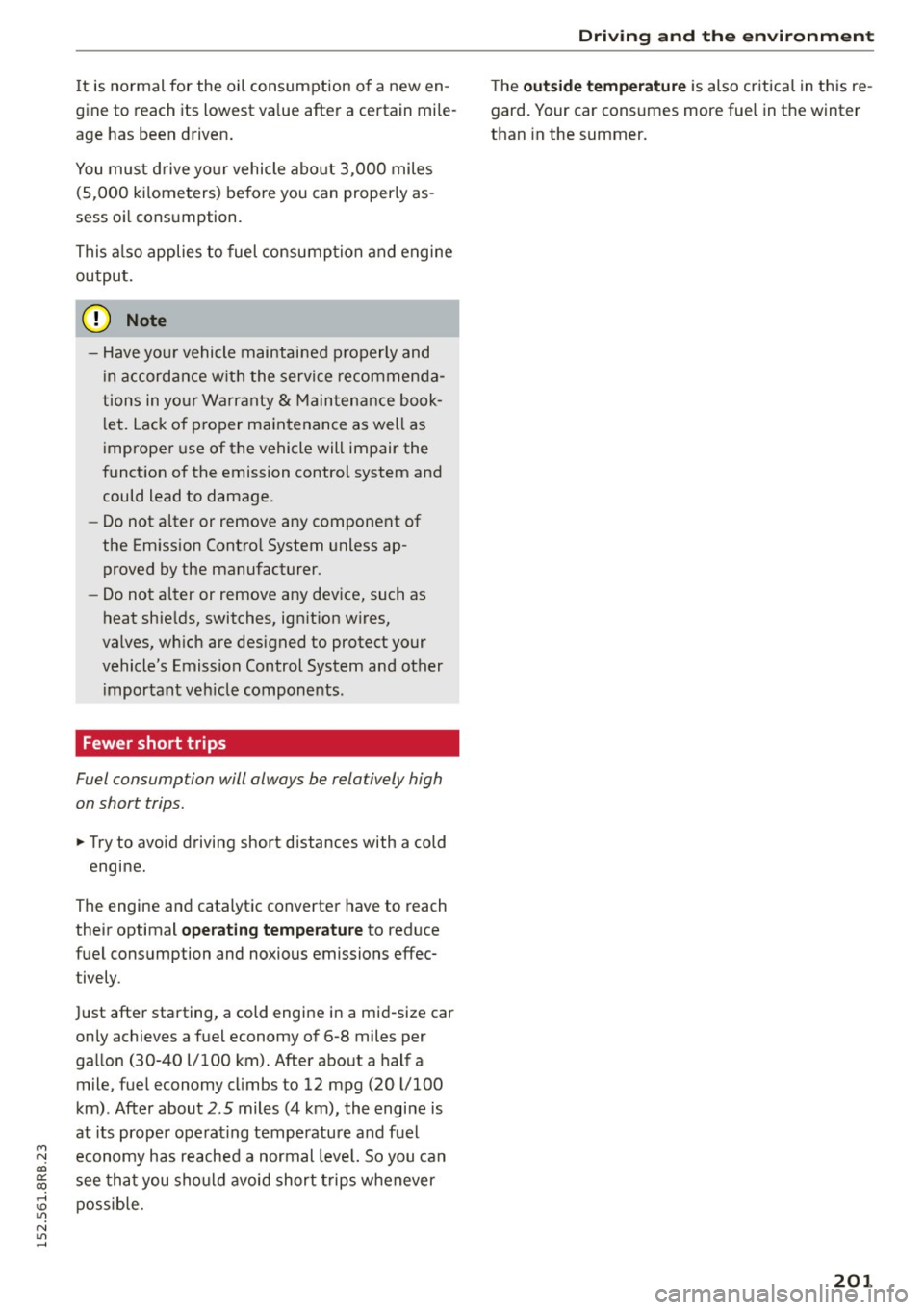
M N
co
a:
co
,...., \!) 1.1'1
N 1.1'1 ,....,
It is normal for the oil consumption of a new en
gine to reach its lowest va lue after a certain mile
age has been driven.
You must d rive yo ur vehicle about 3,000 miles
(5,000 kilometers) before you can properly as
sess oi l consumption.
This also applies to fuel consumption and engine
output.
(y Note
- Have you r vehicle maintained properly and
in accordance with the service recommenda
tions in your Warranty
& Maintenance book
l et. Lack of proper maintenance as well as
improper use of the vehicle will impair the
funct ion of the emission control system and
could lead to damage.
- Do not alter or remove any component of
the Emission Contro l System unless ap
proved by the manufacturer.
- Do not alter or remove any device, such as
heat shields, switches, ign it ion w ires,
valves, wh ich are designed to protect your
vehicle's Emission Control System and other i mportant vehicle components.
Fewer short trips
Fuel consumption will always be relatively high
on short trips .
.. Try to avoid driving short distances with a cold
engine.
The engine and catalytic converter have to reach
their optimal
operating temperature to reduce
fuel consumption and noxious emissions effec
tively.
Just after starting, a cold engine in a mid-size car
only achieves a fuel economy of 6-8 miles per
gallon (30-40 l/100 km). After about a half a
mile, fuel economy cl imbs to 12 mpg (20 l/100
km) . After about
2.5 miles (4 km), the engine is
at its proper operating temperature and fuel
economy has reached a normal level. So you can
see that you should avoid short trips whenever
possib le.
Driving and the environment
The outside temperature is also critical in this re
gard. Your car consumes more fuel in the winter
than in the summer.
201
Page 208 of 302

Trailer mode
Weight distribution
Towing a loaded trai ler with an empty car res ults
in a high ly unstable distribution of weight. If this
cannot be avoided , drive at very low speeds only
to avoid the risk of losing steering contro l.
A "balanced" rig is easier to operate and control.
This means that the tow vehicle should be loaded
to the extent possible and permissible, while
keeping the trailer as light as possible under the
circumstances. Whenever possible, transfer
some cargo to the luggage compartment of the
tow vehicle while observing tongue load require
ments and vehicle loading considerations .
Speed
The higher the speed, the more difficult it be
comes for the driver to control the rig . Do not
drive at the maximum permiss ible speed. Reduce
your speed even more if load, weathe r or wind
conditions are unfavorable - particularly when
going downhill.
Reduce vehicle speed
immediately if the trailer
shows the s lightest sign of swaying .
Do not try
to stop the swaying by accelerating.
Observe speed limits. In some areas, speeds for
veh icles towing trailers are lower than for regular
ve hicles .
A lways app ly brakes ear ly. When driving down
hill, shift into a lower gear to use the engine
brak ing effect to slow the vehicle. Use of the
brakes alone can cause them to overheat and fa il.
Coolant temperature
The coolant temperature gauge c::> page 10 must
be observed carefully.
If the need le moves close
to the upper end of the scale, reduce speed im
mediately and/or turn off the a ir condit ioner.
If the coo lant temperature warning light in the
instr ument cluster starts flashing •• pu ll off
the road, stop and let the engine
idle for about
two minutes to prevent heat build-up.
A WARNING
Anyone not properly restrained in a moving
vehicle is at a much greater r isk in an acc i-
206
-
dent. Never let anyone ride in your car who is
not properly wearing the restraints provided
by Audi.
Trailer mode notes
Important to know
Your vehicle handles differently when towing a
trai ler because of the additiona l weight and dif
ferent we ight distribution . Safety, performance
and economy will greatly depend on how careful
l y you load your trailer and operate your rig.
Before you actua lly tow your trai ler, practice
turning, stopping and backing up in an area away
from traffic . Keep practicing until you have be
come comp lete ly familiar with the way your vehi
cle-trailer comb inat ion behaves and responds.
Backing up is difficult and requires practice. Back
ing up with a trai ler generally requires steering
action opposite to that when backing up your ve
hicle without a tra iler.
Maintain a greater distance between your vehicle
and the one in front of you. Yo u will need more
room to stop. To compensate for the trailer, you
will need a larger than normal turn ing radius.
When passing, remember that you cannot accel
erate as fast as you norma lly wou ld because of
the added load. Make sure you have enough room
to pass. After passing, allow plenty of room for
your tra iler before changing lanes again.
Avoid jerky starts , sharp t urns or rapid lane
changes.
@ Tips
- Do not tow a trailer during the break-in peri
od of your vehicle.
- If you tow a trailer, your Audi may requi re
more frequent maintenance due to the ex
tra load
c::> page 281.
Page 214 of 302

Care and cleaning
avoid scratches, move the scraper on ly in
one direction and not back and forth.
- Never remove snow or ice from door win
dows and mirrors using warm or hot water
because this could cause cracks to form.
- To avoid damage to the rear window de fogger, do not apply any stickers on the
heating wires on the inside of the window .
- Decorati ve p art s/ trim
- Never use chrome care or clean ing prod-
ucts .
- Paint
- To reduce the ris k of sc ratches, the veh icle
must be free of d irt and dust befo re po l
ishing or waxing .
- T o prevent paint damage, do not polish o r
wax the veh icle in direct sun light.
- To reduce the ris k of paint damage, do not
polish away rust spots.
- Remove cosmet ics and sunscreen immedi
ately -these could damage the paint.
- Di spla ys
- To avoid scratches, do not use dry cleaning
methods on displays.
- Control s
- Make sure that no flu ids enter the con-
tro ls, because this cou ld cause damage.
- Safety belt s
- Do not remove the safety be lts to clean
them.
- Never clean safety belts or the ir compo
nents chemically or wi th cor rosive f luids
or so lvents and never al low sha rp objects
t o come into con ta ct w ith the safe ty belts.
T his could cause damage to the belt web
bing .
-If there is damage to the webbing, the
connections, the retractors or the b uckles,
have them replaced by an autho rized deal
er.
- Textiles /artificial le athe r/Alcantara
- Never treat artificia l leather/Alcantara
w ith leather care products, solvents, floor
polish, shoe polish, spot remove or simi lar
products.
- Have a specialist remove stubborn stains
to prevent damage.
212
- Neve r use steam cleaners, brushes, hard
sponges, etc . when cleaning .
- D o not turn on the seat heating* to dry
the seat.
- Objects w ith sharp edges s uch as zippe rs,
rivets on clothing or be lts can cause dam
age to the surface.
- Open hook and loop fasteners, for exam
p le on clothing, can damage seat covers .
Make sure hook and loop fasteners are
closed.
- Natu ral leathe r
- Never treat leather w ith solvents, floor
polish, shoe polish, spot remover or simi
lar p roducts .
- Objects w ith sharp edges such as zippers,
rivets on clothing or be lts can cause dam
age to the surface .
- Neve r use steam cleaners, brushes, hard
sponges, etc. when cleaning .
- Do not turn on the seat heating * to dry
the seat.
- To help prevent the leather from fad ing,
do not leave the vehicle in d irect sunlight
for long periods of time . If leaving the ve
h icle parked for long periods of t ime, you
should cove r the leathe r to protect it from
d irect sunlight.
{D Tips
- Insects are easier to remove from paint that
has been fresh ly waxed.
- Regular waxing can prevent rust spots from
forming.
Placing your vehicle out
of service
If you would like to take your vehicle out of serv
ice for a longer time, contact your authorized
A udi dealer or qualified repair facility. They will
advise you of important measures, such as corro
s ion protection, maintenance and storage proce
dures. Also follow the information about the bat
tery~
page 230 .